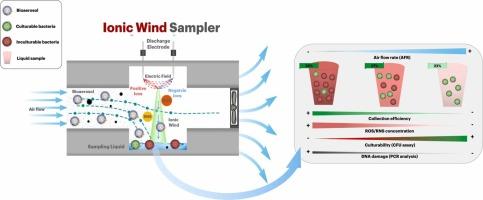Application of ionic wind in sampling of bioaerosols: collection efficiency, ROS/RNS production, and viability assessment
IF 12.2
1区 环境科学与生态学
Q1 ENGINEERING, ENVIRONMENTAL
引用次数: 0
Abstract
Studies of bioaerosol particles in airborne particulate matter have revealed their omnipresence. Therefore, spot-on sampling and identification are pivotal for assessing exposure risks. Corona discharge-based sampling has been utilized for the bioaerosol sampling. However, one of the issues regarding corona discharge-based samplers is the production of reactive oxygen species (ROS) and reactive nitrogen species (RNS), which can alter the viability of bioaerosols and damage nucleic acids. Herein, the use of ionic wind as a possible alternative to reduce ROS/RNS damage to microorganisms was studied. An aerosol-to-hydrosol (ATH) ionic wind (IW) sampler was developed and compared with an ATH electrostatic precipitation (ESP) sampler having the exact physical dimensions in terms of collection efficiency, ROS/RNS production, ozone generation, viability of collected biological particles, and damage to the nucleic acids of the particles. Overall, the ESP sampler showed a higher collection efficiency and less damage to the reproducibility of the sampled bioaerosols than the IW sampler. However, polymerase chain reaction analysis of the sampled bioaerosol nucleic acids showed similar results for both devices. The IW sampler has the potential for both bioaerosol sampling and deactivation, as well as for scenarios requiring neutralized sampled particles or particle deposition on any nonmetallic surface.

离子风在生物气溶胶采样中的应用:收集效率、ROS/RNS 生成和活力评估
对空气颗粒物中生物气溶胶粒子的研究表明,它们无处不在。因此,现场取样和识别对于评估暴露风险至关重要。生物气溶胶采样一直采用电晕放电采样法。然而,电晕放电采样器的一个问题是会产生活性氧(ROS)和活性氮(RNS),它们会改变生物气溶胶的活力并破坏核酸。在此,我们研究了使用离子风作为减少 ROS/RNS 对微生物损害的可能替代方法。研究人员开发了一种气溶胶-水溶胶(ATH)离子风(IW)采样器,并在收集效率、ROS/RNS 产生量、臭氧产生量、收集到的生物颗粒的存活率以及对颗粒核酸的损害等方面,将其与物理尺寸完全相同的 ATH 静电沉淀(ESP)采样器进行了比较。总体而言,与 IW 采样器相比,ESP 采样器的收集效率更高,对采样生物气溶胶再现性的损害更小。不过,对采样生物气溶胶核酸的聚合酶链反应分析表明,两种设备的结果相似。IW 采样器既可用于生物气溶胶采样和失活,也可用于需要中和采样颗粒或颗粒沉积在任何非金属表面的情况。
本文章由计算机程序翻译,如有差异,请以英文原文为准。
求助全文
约1分钟内获得全文
求助全文
来源期刊

Journal of Hazardous Materials
工程技术-工程:环境
CiteScore
25.40
自引率
5.90%
发文量
3059
审稿时长
58 days
期刊介绍:
The Journal of Hazardous Materials serves as a global platform for promoting cutting-edge research in the field of Environmental Science and Engineering. Our publication features a wide range of articles, including full-length research papers, review articles, and perspectives, with the aim of enhancing our understanding of the dangers and risks associated with various materials concerning public health and the environment. It is important to note that the term "environmental contaminants" refers specifically to substances that pose hazardous effects through contamination, while excluding those that do not have such impacts on the environment or human health. Moreover, we emphasize the distinction between wastes and hazardous materials in order to provide further clarity on the scope of the journal. We have a keen interest in exploring specific compounds and microbial agents that have adverse effects on the environment.
 求助内容:
求助内容: 应助结果提醒方式:
应助结果提醒方式:


